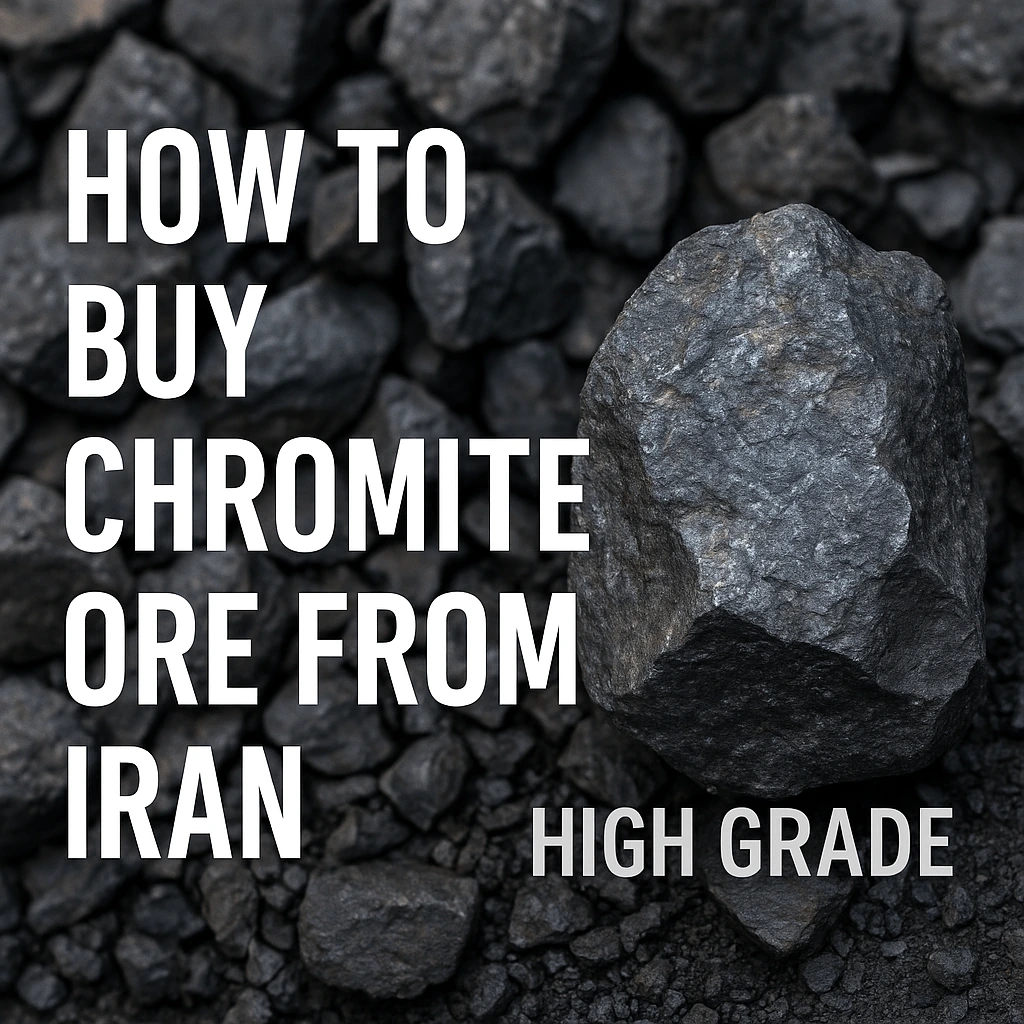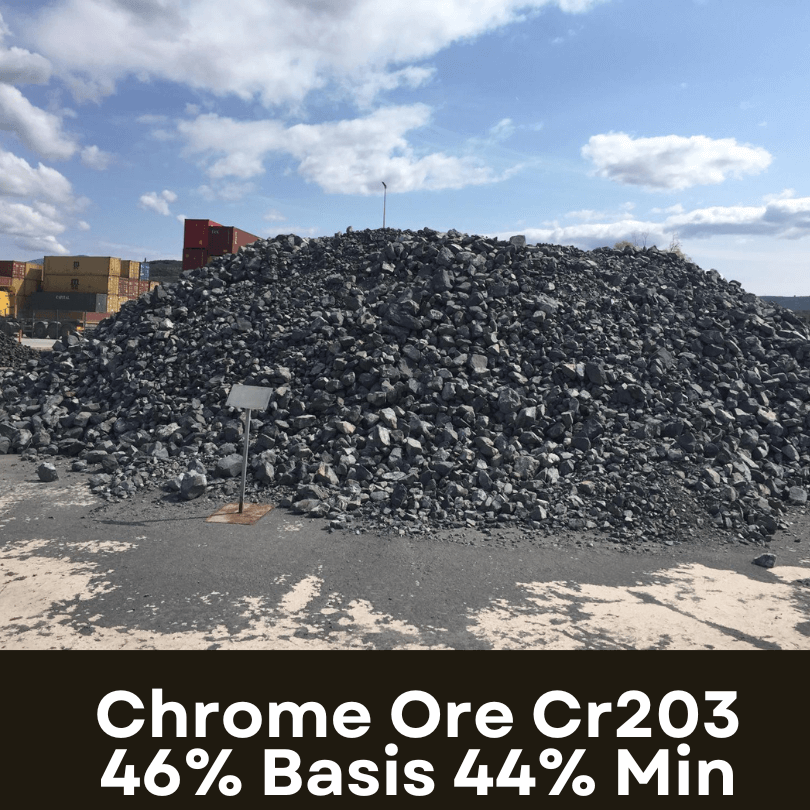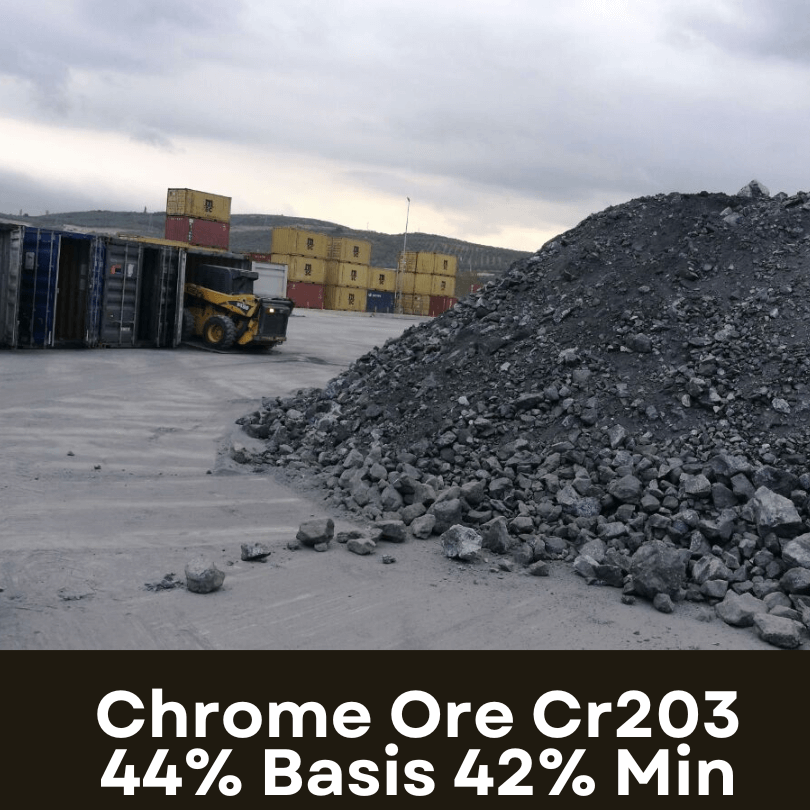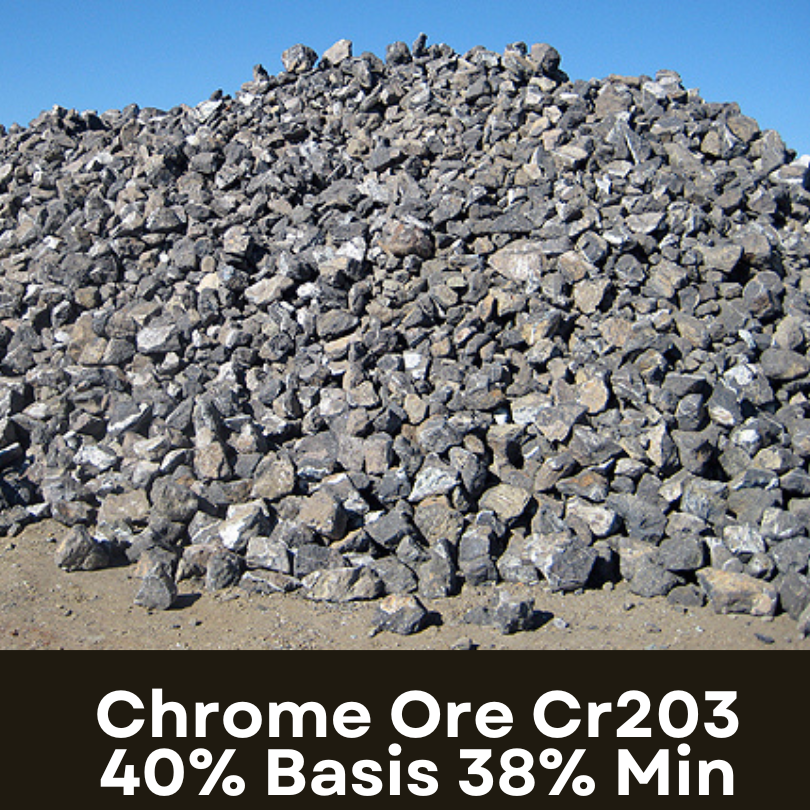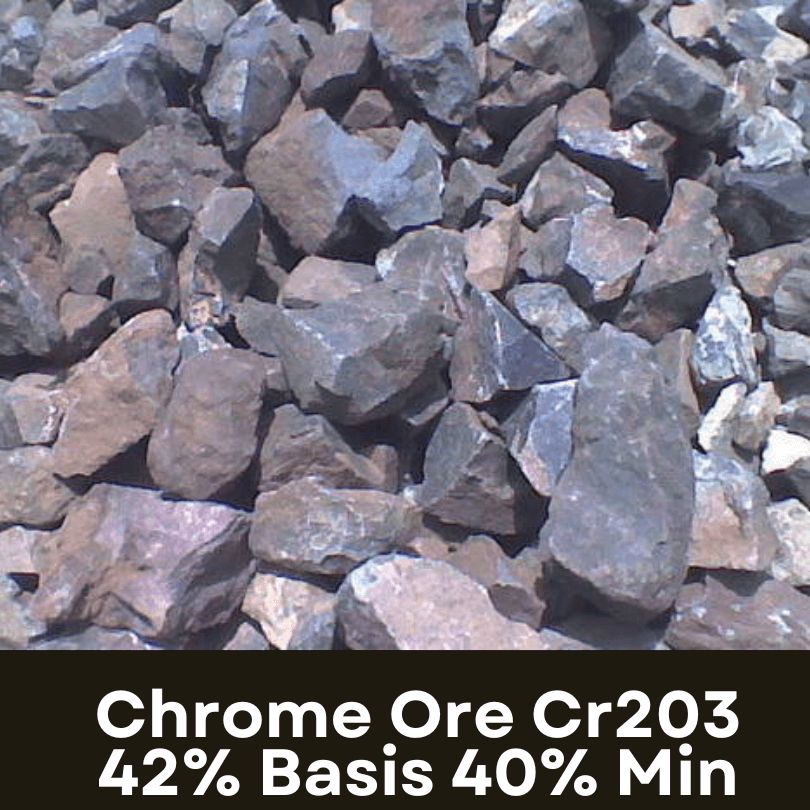Quality Assurance:
We supply the best Iranian chromite available, sourced from the finest suppliers in the country. Various analyzing milestones, including onsite analysis by reputable centers in Iran, Bandar-Abass analysis conducted by the world's leading testing company SGS, and destination analysis by CIQ, will be performed at different times to ensure order quality and quantity.
Price Assurance:
Iran Chromite group can supply an infinite amount of chromite at the lowest market price, thanks to their strong relationships with over 100 suppliers and miners. You don't have to believe us, compare our price with other suppliers and see for yourself. Don't hesitate to reach out to us today for a quote.
A legally robust contract.
Upon reaching a consensus on the commercial and technical aspects, a comprehensive contract will be issued along with a final invoice and a receipt confirming payment. These documents will serve as substantial evidence for any legal entities in Iran.
Get Sample First!
We offer a sample of 50 MT of any products you want for orders above 500 MT. Test the product first and ensure the quality and then place your order.
Introduction:The Ultimate Guide to Buy Chromite Ore
How to buy chromite ore? Chromite ore is a naturally occurring mineral found primarily in ultramafic rocks. It’s primarily composed of iron, chromium oxide, and a touch of oxygen. The glint of black and brown in those rocks – that’s chromite. It’s the main source of chromium. The same chromium used in stainless steel, leather tanning, and in the beautiful chrome finishes you see on cars.
The chromium extracted from chromite is indispensable in modern metallurgy. Think stainless steel – resistant to rust and corrosion. That’s because of a thin layer of chromium oxide that forms on its surface, preventing further oxidation.
Chromium, when added to iron and nickel, creates a superalloy. We’re talking about alloys that can withstand extreme temperatures and pressures. Rocket engines, turbine blades – they all owe it to chromite.
If you’re seeking to purchase chromite products, Iran Chromite can guide you through the entire process and guarantee the supply of high-quality chromite at the best market price.
Let’s dive into the guide:
Chromite Ore: Formation and Extraction
Geological Formation of Chromite Ore
Chromite ore is a naturally occurring mineral that is the primary source of chromium, a crucial element used in various industrial applications, including stainless steel production, alloys, and pigments. It is typically found in ultramafic rocks and is prized for its high chromium content.
Related article: What is Chromite Ore and Where is it Found?
Nature has a peculiar way of creating minerals, and chromite’s no exception. This ore forms when magma from the Earth’s mantle moves upwards and solidifies in the crust – creating what we call ultramafic rock. The high temperature and pressure in this environment make it a haven for chromite crystals to form. Now, these are not just any rocks; they’re packed with valuable minerals, especially chromite. It’s fascinating, right? Every time I encounter these rocks, it feels like unwrapping a precious gift from Mother Nature.
Check out the chrome ore fine page if you require chromite that is smaller in size and has a higher percentage of Cr2O3.
Modern Mining Techniques for Extraction
Modern mining has come a long way since the days of pickaxes and dynamite. Now, we employ sophisticated machinery and techniques. One common method is the open-pit mining – basically, we dig a big hole and scoop out the ore. It sounds simple, but believe me, the engineering behind it is mind-blowing. Then there’s the underground mining, which is a bit more, let’s say, adventurous. This is where tunnels and shafts are dug to reach the chromite deposits deep down. And with the advancements in technology? it’s like a sci-fi movie down there! Robots, drones, and remote-controlled machinery… It’s a dance of machines and skilled engineers, all working together to extract this precious mineral.
Extraction methods are geared towards obtaining a concentrate with a high percentage of chromium oxide (Cr2O3). such as:
Open-pit mining is an option for chromite mineralization that is located near the surface. The ore is dug up and brought to the surface for additional processing.
Underground mining is used for ore bodies located deeper below the Earth’s surface. Both room and pillar and sublevel caving methods are included.
Read More:Methods of Chromite Ore Extraction: A Detailed Overview
Types of Chromite Ore
Metallurgical Chromite
Metallurgical chromite primarily serves in the steel industry. It’s like the bread and butter of chromite ores. Think about it: when you’re manufacturing stainless steel, you need a high-quality alloy, right? That’s where this type of chromite steps in. The chromium extracted from metallurgical chromite provides resistance to corrosion and tarnishing, which is crucial. I’ve always been amazed by how such a mineral can drastically change the properties of steel.
Refractory Chromite
Refractory chromite is primarily used in the making of high-temperature bricks for furnaces. So, if you’re thinking of those massive furnaces used in various industries, you’re on the right track. These bricks can withstand incredibly high temperatures. The high alumina and low silica content in refractory chromite gives it that unique ability. I can’t stress enough how essential these bricks have been in many of my projects, ensuring furnaces stand the test of time.
Chemical Chromite
Chemical chromite is often overshadowed by its siblings, but it has its niche. This variant is mainly used in the chemical industry, producing chromium salts and pigments. Have you ever admired the vibrant colors in textiles, paints, and inks? Well, some of them might just owe their hue to chromium pigments derived from this type of chromite.
Buy Chromite Ore: Main Uses and Applications
Production of Ferrochrome for Stainless Steel
Chromite ore is essential in producing ferrochrome—an alloy of chromium and iron. Ferrochrome, in turn, is super crucial for producing stainless steel. Stainless steel, as you might guess, is used almost everywhere—from your kitchen sink and cutlery to those massive skyscrapers dotting city skylines. Every time I see a stainless-steel appliance, I’m reminded of the chromite ore working silently behind the scenes. Read more about relationship between chrome ore and Ferrochrome.
Chromite in the Refractory Industry
The refractory industry is another area where chromite shines bright! Refractories are materials designed to withstand really high temperatures, think of them as the superheroes of heat resistance. Chromite, due to its excellent heat-resistance properties, plays a significant role in manufacturing these materials. They’re used in furnaces, kilns, incinerators—you name it! I’ve always felt a connection when seeing these massive structures, knowing the role chromite plays in keeping things stable and heat-efficient.
Role in the Chemical Industry
Lastly—but by no means least—is chromite’s role in the chemical industry. Without getting too geeky, chromite is used to make sodium chromate, which is a precursor to several chromium chemicals. These chemicals have a wide range of applications, from leather tanning to wood preservation.
Quality Indicators and Standards of Chromite Ore:
When you’re in the mining game as long as I’ve been, especially with chromite, you understand how pivotal quality is. The backbone of determining the value of Chromite ore – it’s all in its purity and composition. The higher the chromium content, the more valuable and efficient the ore.
Ever heard the saying “It’s not all that glitters is gold”? In the world of chromite, it’s not all that shines that’s of high quality. Determining Purity and Composition is the very first step. To know the ore’s actual worth, you’ll want to look for the ratio of chromium to iron. A higher ratio means greater purity.
Accepted Industry Standards are the bread and butter of the trade. The ASTM (American Society for Testing and Materials) sets certain standards for chromite ore. These standards ensure that buyers get what they’re paying for – no nasty surprises. And believe me, in my decade-long career, I’ve seen many rely on these standards, making transactions smoother and less disputable.
The Role of Impurities and Their Impact can be – well – quite impactful. Silica, for instance, can reduce the ore’s melting point, making it less efficient for certain applications. And then there’s alumina, which, when in excess, can affect the ore’s refractoriness.
Impurities not only affect the ore’s performance but can also reduce its market value. So, when buying chromite ore, always – and I mean always – keep an eye out for these uninvited guests.
Geographical Distribution and Major Producers
First off, let’s talk about the top dogs in chromite production. Have you heard about South Africa? Well, they’re leading the pack! Followed closely by Kazakhstan. Other major players include India, Turkey, Zimbabwe and Iran. These countries boast some of the largest reserves and highest production of chromite ore. It’s like they’ve hit the jackpot!
Now, diving into factors affecting regional production. Geology plays a pivotal role; certain regions are blessed with rich, high-grade ores. But it ain’t just about what’s underground. Infrastructure – roads, ports, and processing facilities – they’re the arteries and veins of this industry. A country might have vast reserves, but if transporting the ore is like pulling teeth, then it’s a no-go. Political stability is another biggie. If a region is fraught with unrest or stringent regulations, mining companies might think twice before diving in. Weather conditions; I’ve been rained out of sites and battled dust storms. Extreme weather can halt production or even damage equipment. Lastly, global market demand and prices can either boost or dampen production enthusiasm.
Chromite Ore Price
Current Price Trends and Influences
The price of chromite ore is, like any other commodity, subject to the whims of supply and demand. Recent years have seen significant fluctuations. With the rise of industries relying on stainless steel and other alloys – think about those high-rises and fancy kitchen appliances – demand for chromite, which is a key ingredient in ferrochrome production, has skyrocketed. But wait, there’s more! Geopolitical tensions, labor strikes, and even weather conditions in key mining regions.
Forecasted Market Changes and Their Causes
Forecasting? The thing is, while we can look at historical trends and make educated guesses, the future of chromite prices is, well, as clear as mud. Emerging economies are ramping up their infrastructure projects. This could drive up demand. On the flip side, technological innovations might reduce the need for chromite in some industries. And, of course, there’s the ever-present specter of alternative materials coming into play. It’s like juggling balls – you never know which one’s gonna drop next.
Impact of Political and Environmental Regulations
Political and environmental regulations play a massive role. I’ve been in situations where a regulation shift has turned a profitable venture into, well, a not-so-profitable one. Countries with rich chromite deposits might impose stricter regulations, be it for environmental reasons or worker rights. These can drive up production costs. On the global stage, trade restrictions and tariffs can also throw a wrench in the works. But it’s not all gloom and doom. Sometimes these regulations ensure sustainable mining and better quality ore. It’s a double-edged sword – benefitting in some ways and, well, not so much in others.
How can a buyer identify high-quality Chromite Ore from lesser grades?
The quality of chromite ore can be determined based on several criteria, which indicate the ore’s suitability for specific applications. When buyers evaluate chromite ore, they often consider the following factors:
Chromium to Iron Ratio (Cr:Fe):
One of the primary indicators of chromite quality is the Cr:Fe ratio. High-quality metallurgical grade chromite has a high Cr:Fe ratio. A higher ratio is desirable for metallurgical processes, as it means there’s a higher proportion of chromium compared to iron.
Chromium Oxide (Cr₂O₃) Content:
Metallurgical grade chromite typically has a high Cr₂O₃ content, often above 40%. Chemical and foundry grade chromites, on the other hand, might have even higher Cr₂O₃ content. This parameter gives an idea of the ore’s chromium content.
Impurities:
The concentration of impurities such as silica (SiO₂), alumina (Al₂O₃), and other trace elements can impact the quality of the ore. High silica content, for instance, is undesirable in metallurgical grade chromite as it can affect the smelting process.
Physical Properties:
The size, hardness, and moisture content of the ore can affect its processing and handling. Buyers may have preferences based on their specific processing equipment and requirements.
Refractoriness:
For refractory applications, the ore’s ability to withstand high temperatures without deforming or melting is crucial.
Source & Geology:
The geological origin of chromite ore can influence its quality. For instance, podiform deposits, often found in ophiolite complexes, might produce high-grade lumpy ores. On the other hand, stratiform deposits, typically associated with layered intrusions, can produce massive ore bodies with varying qualities.
Consistency:
Reliable suppliers who can provide ore with consistent quality over time are preferred. Consistency ensures predictable performance in downstream applications.
Previous Usage & Reputation:
If the ore from a particular mine has been used successfully in the past for certain applications, it can serve as a testament to its quality.
Buy Chromite Ore: Tips for Buyers
Questions to Ask Your Supplier
First and foremost, always remember the age-old idiom: “Knowledge is power.” Before sealing the deal, you’ve got to be inquisitive. Some must-ask questions include:
- Where is the chromite ore sourced from?
- What’s the Cr2O3 content? That’s the main selling point of chromite.
- Are there any associated impurities or minerals?
- What are your extraction and processing methods?
- ALWAYS – ask for a sample. Trust me on this; it’s better to be safe than sorry.
Ensuring Quality and Purity
Quality and purity. Trust your gut, but back it up with science. First off, familiarize yourself with industry standards. In the chromite game, there’s a saying – “If it’s not shiny, it ain’t the real deal!” Well, not exactly, but you get the drift. Look for a rich, lustrous appearance, but don’t stop there. Lab tests, especially for Cr2O3 content, are paramount. Keep an eye out for unwanted impurities like silica and alumina. Remember, every speck counts when it comes to ensuring top-notch chromite ore.
Buying Chromite Ore: Storage and Transportation
Best Practices for Storage
Chromite ore, like other minerals, has its own set of quirks when it comes to storage. From my years in the mining trenches I’ve learned a thing or two about how to store this valuable commodity.
First and foremost, keep the ore in a dry and cool environment. Humidity? That’s a big no-no. It can lead to the degradation of the ore’s quality. Some miners even use silo storage or covered sheds to protect the ore from unpredictable weather conditions. Another tip? Regularly rotate the stock. That ensures that you’re not leaving any batch of ore untouched for too long, which can lead to issues with quality down the line. and don’t forget to keep the storage area clean! Nobody likes contaminated chromite.
Tips for Safe and Efficient Transportation
Transporting chromite ore is not just about throwing it in the back of a truck and hoping for the best. If only it were that simple! From my days of coordinating shipments, I’ve picked up a trick or two. For starters, use containers or bulk bags. These not only protect the ore but also make it easier to load and unload.
Choosing the right mode of transportation is vital. Trucks are often used for shorter distances, while rail or sea transport might be better for long-distance hauling. Whatever you choose, make sure the vehicle is in top-notch condition. Breakdowns? Delays? Ain’t nobody got time for that!
Lastly, keep all documentation handy. Customs, checks, and clearances can be a real hassle if you’re not prepared.
Managing Logistics and Costs
Managing logistics and costs can be a bit of a juggling act, but with a little finesse, you can nail it. It’s crucial to establish relationships with reliable transportation providers. I’ve seen too many businesses get burned by going for the cheapest option only to face delays and unforeseen expenses. Not cool.
Consider using software or digital tools to help track shipments and costs. Trust me; it’s a lifesaver. It helps streamline the process, and you’ll always know where your shipment is at any given time. and let’s talk about insurance. It might seem like an added expense, but it’s essential. Accidents, losses, damages – these things happen. Better to be safe than sorry, right?
Also, always be on the lookout for hidden fees. Port charges, handling fees, you name it. They can sneak up on you, and before you know it, your costs have skyrocketed. Keeping a keen eye on these and negotiating when possible is key.
Summary: Buy Chromite Ore
If you’re thinking to buy chromite ore, there are some vital factors you’ll want to consider. Chromite ore is a key source of chromium, that precious metal used for making stainless steel, textiles, and even some dyes.the origin of the ore,the grade and composition of the ore, prices fluctuate based on supply and demand, geopolitical situations, and even environmental factors.
FAQ
What is the difference between Chromite and Chrome?
Chromite is mined and then processed to extract the chromium. The chromium extracted is then used in various industries, most notably for making stainless steel due to its high corrosion resistance.
Are there any alternatives to Chromite Ore in industry applications?
There isn’t a direct substitute for all its uses due to the unique properties chromium imparts to its applications.
Is Chromite Ore renewable, and what are the environmental implications of its extraction?
Chromite ore, like other mineral resources, is non-renewable. Once it’s extracted from the Earth and used, it cannot be replaced on human timescales. The amount of chromite ore available in the Earth’s crust is finite, and over time, as with other non-renewable resources, the most accessible and highest quality deposits may become depleted, leading to increased extraction costs and potential supply challenges.

